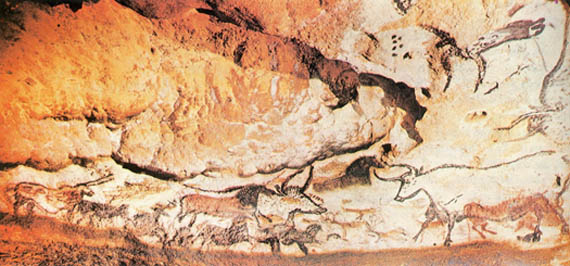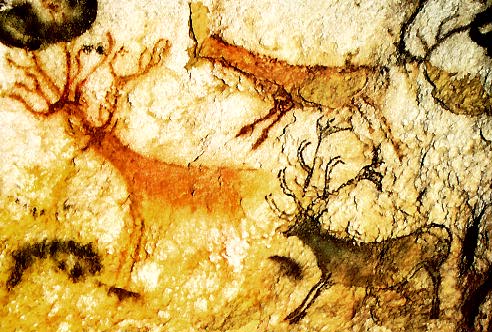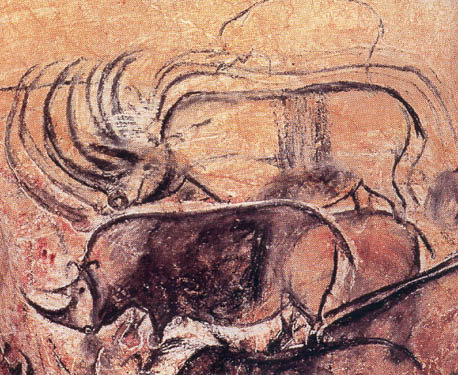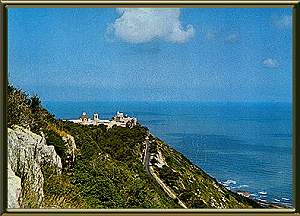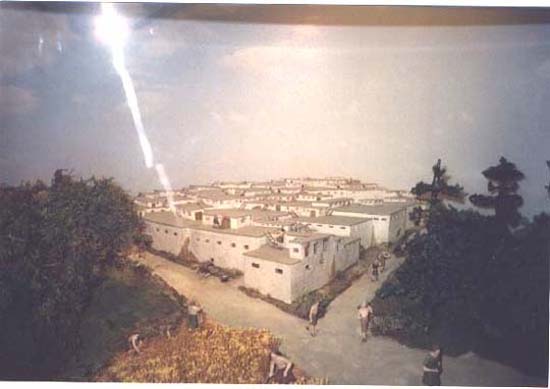CREATION OF THE UNIVERSE: 13.7 billion years ago. The Big Bang released outward, possibly forever, the matter and energy that would later form all the clusters, galaxies, stars and planets here in the present day. Whether the original super-dense blob was a naturally occurring phenomenon or created by a force (deity) outside the laws of nature, is unknown.
THE MILKY WAY FORMS: 13.2 billion years ago. Our galaxy is old, it formed early on in its trip outward, from the same gas and dust that all galaxies have formed from. The oldest stars in our galaxy prove it. In fact, 2/3 of Milky Way Galaxy history happened before the Sun was even born, the same way most (almost all) of Earth's history went by before the earliest caveman walked the African savanna.

BIRTH OF THE SUN: 4.6 billion years ago. We were once a nebula. The Sun and all the planets formed from what must have been a nice nebula of gas and dust, as discovered by Immanuel Kant (1755) and confirmed by Pierre de Laplace (1798). Once enough matter came together at the center of the cloud, it hit an essential critical mass, and the Sun turned on its natural nuclear fusion furnace, which has been shining ever since, giving out neighborhood in the sky a new cosmic lighthouse, by which tall ships may steer the depths of space.

BIRTH OF THE PLANET EARTH: 4.54 billion years ago. On the outskirts of the original rotating cloud, gas and dust accreted too, but none of the other coagulations were massive enough to ignite as a star. Earth and all the other planets, comets, moons and asteroids found their places in the Solar neighborhood. Scattered impacts (and a Giant Impact) would yet to add additional matter to the young Earth's mass.

HADEAN EON: 4.54-3.8 billion years ago. For a billion years, Earth circles the young Sun without any life around to see it. As Earth grows and clears its area in space of matter, another planet (smaller than Earth) approached and collided with Earth. From the wreckage, the Moon is formed. At the same time, during the 'Late Heavy Bombardment' phase, comets struck our world rapidly, bringing with them all the water that we still swim in and drink today. The crust hardens by the end of this 'infernal' Eon.

ARCHEAN EON: 3.8-2.5 billion years ago. Super simple life, prokaryotes without even a nucleus, 'dominated' the landscape for two billion years, taking the meager energy available from non-living material (organic molecules of air and liquid ocean). The atmosphere thickened, and then cyanobacteria emerged, using chlorophyll systems that converted sunlight into energy. Eventually, these bacteria were able to store organic molecules and use them later... food. So they were fruitful and multiplied. These bacteria also added a waste product into the atmosphere that changed the course of history... oxygen.
PROTEROZOIC EON: 2.5 billion years ago - 542 mya. Plate tectonics reshape the look of the Earth, continents emerge, at one point the whole planet was covered with ice, called the 'snowball earth.' Oxygen, the gas we breath, became more dense, and that gave more energy for things to grow bigger- and grow specialized parts and a core from which complex directions can be handled: the nucleus. These new eukaryotes dominate, and are still the primary cell type on Earth- even our cells are eukaryotes. 5/6 of Earth's history has passed by now, and there is nothing more advanced than an amoeba. About 800 mya, multi-cellular organisms came into being.

PHANEROZOIC EON: PALEOZOIC ERA
"OLD LIFE"
CAMBRIAN PERIOD: 542-488 mya. "Explosion of Life." Microscopic life, on Earth for most of its long history, now takes a great leap forward and grows to the point it is visible. After eons of inferno heat and freezing waste, the temperature warmed. Complex animals such as mollusks date from this time, swimming along the long coastlines of continental shelves. The earliest fossils are from the Cambrian, and our phylum, chordata, dates from this time, when some creature developed a primitive backbone.

ORDOVICIAN PERIOD: 488-443 mya. The Age of Arthropods sees many new and large sea borne species emerge. Moss, plankton, trilobites, and octopus are all here, and on land, plants and scorpions. But land is a harsh place: gravity to pull down your bone-less body, UV rays, bad weather, more energy needed for motion and even eating. Its a wonder they came up at all. But they did, and it is well to remember that even we still have to drink a certain amount of water, or else we die. As well, is it a coincidence that the salt in our blood is the same concentration as salt in the sea? Not at all. It is a reminder that most of our relatives lived all their lives underwater.

SILURIAN PERIOD: 443-416 mya. It was destined that land, the great unknown place, this niche 'up there,' had to be conquered by life. Plants colonized first, they crept out and stretched their leaves toward the Sun, while rooting down into the ground for water. For animals, meanwhile, the sea was so rich in life that the 'eat or be eaten' scenario meant anything that could creep out onto land while keeping water inside somehow, had an advantage. So some (thanks to tides leaving them stranded constantly) developed a way to get oxygen from air, not water (much harder to do). It required a lung. The earliest lunged creatures evolved from fish and still had their gills, we call them amphibians.

DEVONIAN PERIOD: 416-359 mya. Arthropods (spiders, scorpions and some insects) crawl on land. Fish dominated the seas. But amphibians on land were doing something new: in water, streamlining is best, but on land where the medium is air, more leverage is given to appendages (that will eventually allow us to manipulate the cosmos around us, in a way dolphins, which have as large and developed as ours, simply cannot). Also, fire is essential for technology, and is impossible in the water.

CARBONIFEROUS PERIOD: 359-299 mya. All the dead plants and creatures that had existed on Earth up to this point, have fallen into the ground and decayed, ashes to ashes and dust to dust. This leftover dust and ashes, the accumulation of it all, has been enough to make all the fossil fuels that we are now burning in our cars.

PERMIAN PERIOD: 359-299 mya. Amphibians ruled the land, but laid eggs in the water. Over time, some laid the eggs on land, but needed a special kind of egg so the young could live in the harshness of land- an egg surrounded by a thin shell of limestone. Permeable to air but not water: oxygen gets in, water cannot get out. The result was an animal that, unlike its parents, could live on land its whole life: reptiles. Whatever happened to 'rest in peace?'

PHANEROZOIC EON: MESOZOIC ERA
"MIDDLE LIFE"
TRIASSIC PERIOD: 248-205 mya. Reptiles were very successful and dominated the land. Also, a branch evolved into some little creatures, furry, warm blooded and which had hair: mammals. But the Triassic was the Age of the Reptiles. They differentiated and some became huge, some fast, some predators, some prey. They became dinosaurs, but also alligators and turtles.

JURASSIC PERIOD: 205-146 mya. Primitive mammals are still around, the descendents of which are with us today: duck bill platypus, marsupials like kangaroos and opossum. But dinosaurs ruled the Jurassic. The tallest and largest creatures that ever existed on Earth came into being, while some reptiles moved back into the sea. Without humans, nature saw a wide variety of thunder lizard walk the planet.

CRETACEOUS PERIOD: 146-65 mya. Some mammals develop the capability to 'keep the egg inside the mother's body' until the baby was mature. These placental mammals could diffuse food from the mother's bloodstream to the baby, and wastes could be diffused back. The Age of Dinosaurs continued, Tyrannosaurus Rex lived, and many others. As had happened before, a comet racing through space collided with Earth, sending the planet into biological mass extinction. This killed all the dinosaurs, but some mammals survived due to their unique traits- so did birds. The first primates appear, able to use their hands to pick things up.

PHANEROZOIC EON: CENOZOIC ERA
"NEW LIFE"
TERTIARY PERIOD: 65-1.64 mya. In a world suddenly empty of competitors, mammals took over the niches leftover by dinosaurs and reptiles. They grew very large, differentiated more from each other, and some, the primates now, (insignificant from 65-45 mya), evolved in the direction of eyes, hands and brains. Lemurs date from that time. But anthropoids developed nails instead of claws, and thumbs. Some chimps lost their tails (30-17 mya), but stayed small like gibbons. Great apes 9 ft. tall also arrived, but one of the species of chimp became hominids 6 mya, (australopithecine man), who lasted until 1.5 mya).
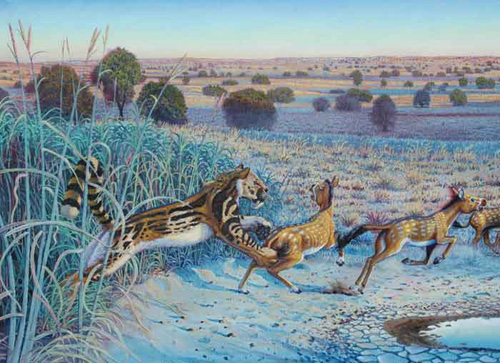
QUARTERNARY PERIOD: 1.64 mya - Today. Bipedal, vertical motion is what we are good at. Bears and chimps can walk on 2 legs, but prefer 4. We don't. Our genus (race), Homo, began with Homo habilis man (2-1.4 mya). The successor, Homo erectus' (1.6 mya - 250,000 years ago), had a spinal cord that made him upstanding, and able to leave Africa. H. erectus was supplanted by Homo sapiens before the Ice Age, all throughout the eastern hemisphere.

CIVILIZATION. Some people built cities for mutual defense. Jericho (Israel) is one such city, the oldest continually settled place on Earth. Catal Huyuk (Anatolia) is another, as are Ebla (Syria) and Susa (Persia). These were isolated places. One of the great developments occurred now, the Agricultural Revolution- farming- which meant that some humans would move from food gathering to food producing. In Europe and the Middle East, wheat and barley were harvested, in China, rice, in India, wheat, in Africa, sorghum and millet, in the Americas, maize and potatoes.

CIVILIZATIONS. While civilization in the singular was built by neolithic tribal groups through the increasingly complex, urban, phenemenon in the ancient Near East, Egypt and later India and China, civilizations in the plural have diverged from these wellsprings. They are the most meaningful geo-spatial features today in the post-Cold War world, because they embody the broadest cultural identities people have. The nation-state system (devotion to the idea of 'country') of world order, dominant since the 1600s in the West, is itself losing ground to them.


